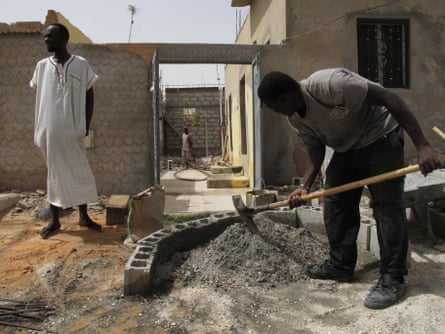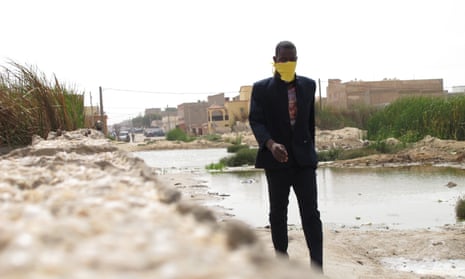The two events are not unrelated. As heads of state fly into Nouakchott’s new airport for the Arab League summit on Monday, Vieux Fall will be raising the roof – and the floor – of his family’s small compound.
“The water table has risen more than usual this year. The toilets are overflowing. We are flooded again,” says the 36-year-old computer technician, standing in a shallow pool of water in his yellow-tiled courtyard.
On the roof of the single-storey dwelling, a bricklayer is building a bedroom. In the street, another man is mixing cement. Downstairs, along all the walls, at a height of 70cm, Fall has drawn a line in blue pencil: the new level of the floor. Wedged between the advancing dunes of the Sahara and the rising Atlantic Ocean, the Mauritanian capital is a prisoner of climate change (pdf).

Nouakchott has no mains drains. Much of the city is at or below sea level, protected from the ocean only by an eroding dune. In the past decade, local and international studies have warned that the city is in danger of being swallowed by the sea. Yet a frenzy of construction has preceded the summit, leading to fears of disastrous flooding when the rains come in August.
“We are getting ready for the rain. We spend all our savings on masonry. It may seem like madness, but we cannot afford to move,” says Fall. He points out a tap, set in the wall just below knee height. “When I was a young man, it was level with my shoulder,’’ he says. “You see, we have raised the floor – and of course all the door frames – by about a metre in the past 15 years.”
Fall shares the compound with his wife, his two children, his younger sister and his widowed mother. The family were allocated the property in the 1980s when Fall’s late father was a customs officer and the Socogim PS neighbourhood came into being as a leafy suburb for civil servants.
“All the trees are dead. The water rising under Nouakchott is salty,” says Siré Camara, 48, the lucky occupant of the tallest building in Socogim PS – the two-storey culture centre he founded in 2006. From the roof, where he is building a third storey, he points out the skeletal trunks of the trees lining the roads. “The only patches of green are the tall reeds growing in the abandoned compounds, and in the primary school and dispensary that never reopened after flooding in 2013,” continues Camara.
“The area is full of stinking ponds where people empty their waste water and throw their household waste. It is disgusting and unhealthy. We have dengue fever, which was completely unknown in Nouakchott before. The best solution would be to move the Mauritanian capital and start again. That is what would happen in a rich country.”
Until 1960, Mauritania was not a mapped entity. Its French colonisers cared about the territory only as a sandy link between north Africa and present-day Senegal. Camel herders sipped green tea at a watering hole called Nouakchott (“the windy place”) with 200 residents and not enough annual rain to fill a thimble.
Now Nouakchott has a population of 800,000, precipitation that registers on bar charts, drinking water piped from Senegal, but still no drains. Three years ago, so much rain fell on Mauritania during August and September that more than 2,000 people were left homeless. In the wake of the emergency, the German cooperation agency (GIZ) designed a network of ditches and pumping stations to evacuate surface water in areas like Socogim PS.
Omnia Aboukorah-Voigt, GIZ project coordinator for climate change in Nouakchott, said: “I don’t think Nouakchott really needs a storm drain but it needs sanitation, better urban planning and management of the coastal zone.
“We are talking about very few days of rain a year. But the number of rainy days is increasing and the problem is the large amount of rain that falls in a very short time. Given the fact that the ground water is really high, when it rains there is no place for the water to infiltrate the ground. The more you build – roads or buildings – the more you are laying a waterproof cover over parts of the city, which will lead to flooding elsewhere.”

In Socogim PS, Camara says the pumps have been a disappointment. They have worked in the immediate run-up to the summit but previously they had not functioned, causing vast pools of stagnant water to build up.
Hamzette Ould Amar, director general of the national water board said residents were to blame.
“The problem is their behaviour. They throw solid waste in the canals. That creates huge problems for the pumps. We have now bought pumps with double the capacity – 120cm3 – and these will solve the problem.”
He claimed a long-term solution – full sanitation – will be operational within three and a half years. However, residents and donors remain sceptical of the extent to which a much-vaunted government contract, signed with China last year, will result in a comprehensive drainage system for all residents of Nouakchott.

Comments (…)
Sign in or create your Guardian account to join the discussion